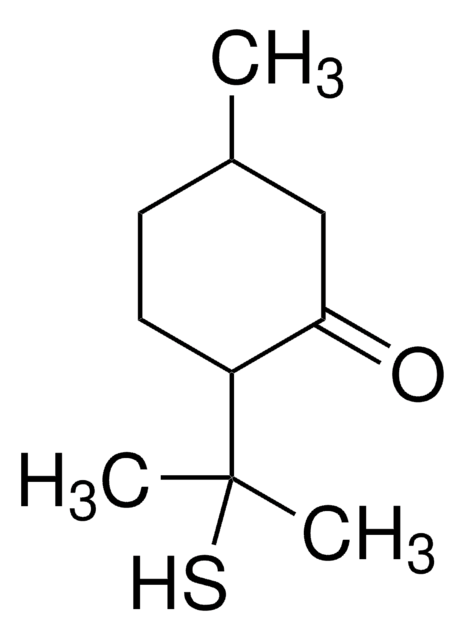W243906
Ethyl hexanoate
≥98%, FCC, FG
Synonyme(s) :
Caproic acid ethyl ester, Ethyl caproate
About This Item
Produits recommandés
Source biologique
synthetic
Niveau de qualité
Qualité
FG
Halal
Kosher
Agence
meets purity specifications of JECFA
Conformité réglementaire
EU Regulation 1334/2008 & 178/2002
FCC
FDA 21 CFR 117
FDA 21 CFR 172.515
Densité de vapeur
5 (vs air)
Pureté
≥98%
Indice de réfraction
n20/D 1.407 (lit.)
Point d'ébullition
168 °C (lit.)
Densité
0.869 g/mL at 25 °C (lit.)
Application(s)
flavors and fragrances
Documentation
see Safety & Documentation for available documents
Allergène alimentaire
no known allergens
Propriétés organoleptiques
banana; green; waxy; fruity; pineapple; sweet
Chaîne SMILES
CCCCCC(=O)OCC
InChI
1S/C8H16O2/c1-3-5-6-7-8(9)10-4-2/h3-7H2,1-2H3
Clé InChI
SHZIWNPUGXLXDT-UHFFFAOYSA-N
Vous recherchez des produits similaires ? Visite Guide de comparaison des produits
Description générale
Application
- Formation of Key Aroma Compounds During 30 Weeks of Ripening in Gouda-Type Cheese Produced from Pasteurized and Raw Milk.: The study investigates the formation of key aroma compounds, including ethyl hexanoate, during the ripening of Gouda-type cheese. The results provide insights into the ripening process and its impact on cheese flavor development (Duensing et al., 2024).
Mention d'avertissement
Warning
Mentions de danger
Conseils de prudence
Classification des risques
Flam. Liq. 3
Code de la classe de stockage
3 - Flammable liquids
Classe de danger pour l'eau (WGK)
WGK 1
Point d'éclair (°F)
127.4 °F - closed cup
Point d'éclair (°C)
53 °C - closed cup
Équipement de protection individuelle
Eyeshields, Faceshields, Gloves, type ABEK (EN14387) respirator filter
Faites votre choix parmi les versions les plus récentes :
Déjà en possession de ce produit ?
Retrouvez la documentation relative aux produits que vous avez récemment achetés dans la Bibliothèque de documents.
Les clients ont également consulté
Notre équipe de scientifiques dispose d'une expérience dans tous les secteurs de la recherche, notamment en sciences de la vie, science des matériaux, synthèse chimique, chromatographie, analyse et dans de nombreux autres domaines..
Contacter notre Service technique












